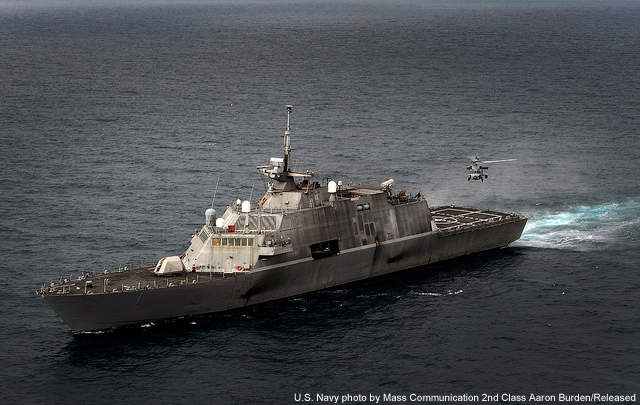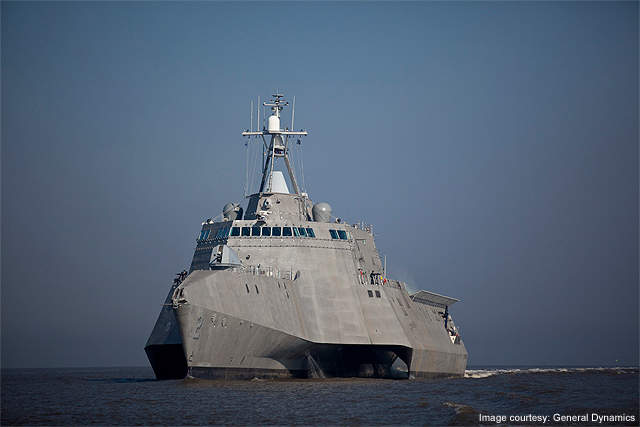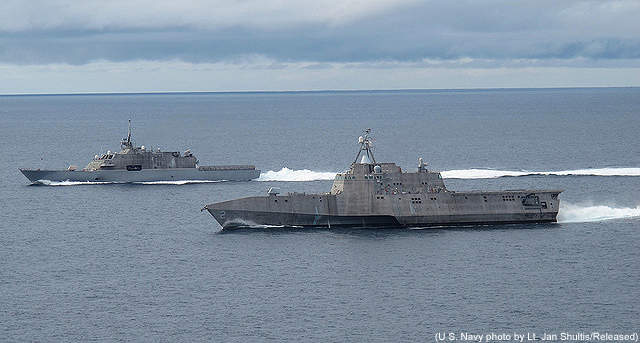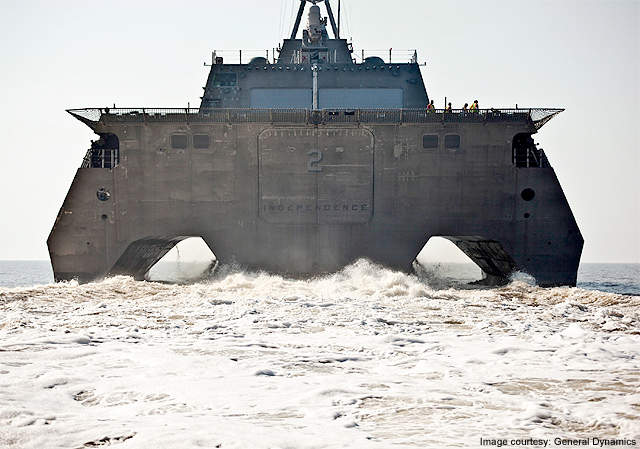The littoral combat ship (LCS) is a new family of surface ships for the US Navy. The LCS is a fast, highly manoeuvrable, networked surface combat ship, which is a specialised variant of the family of US future surface combat ships known as DD(X).
LCS is designed to meet the urgent requirement for shallow-draft vessels to operate in the littoral (coastal waters) to counter growing potential ‘asymmetric’ threats of coastal mines, quiet diesel submarines and the potential to carry explosives and terrorists on small, fast, armed boats.
In May 2004, the US Department of Defense and the US Navy announced the selection of two separate defence contracting teams led by Lockheed Martin and General Dynamics. Each was tasked with carrying out system design and options for the detailed design and construction of two flight 0 or first-generation LCS ships.
The number of LCS ships is not finalised but speculated to be up to 60, within a total US naval fleet of 375 ships.
Austal secured a A$1.6bn ($1.16bn) contract to build LCS ships 32 and 34 in September 2018, followed by a contract for two additional ships, LCS 36 and 38, in December 2018. The Lockheed Martin-led team was awarded a contract to build LCS 31 in January 2019.
Littoral combat ship design
The two designs are quite different, although both satisfy the top-level performance requirements and technical requirements of the LCS programme. They achieve sprint speeds of over 40k and long-range transit distances of more than 3,500 miles. The Lockheed Martin Freedom-class design is a high-speed, semi-planing mono-hull. The General Dynamics Independence-class design is a trimaran with a slender stabilised mono-hull.
The sea frames of both designs accommodate the equipment and crew for core LCS missions and special missions. Both of them can effectively launch, control and recover vehicles for extended periods. However, the strategy for launch and recovery for waterborne craft and aircraft are different for each design. The two designs use very different approaches for incorporating reconfigurable internal volume.
The design approach for the second-generation LCS, flight 1, ship acquisition is flexible and will take into consideration the experience gained in the flight 0 designs. In both designs, the sprint speed ranging between 40k and 50k results in the body of the hull being lifted out of the water as much as possible. The Lockheed Martin design of the mono-hull lifts the body of the hull.
With the slender stabilised mono-hull, the General Dynamics trimaran design uses two outriggers, which move the displacement upwards and reduce the wetted surface. The shaping of the hull in both design strategies provides signature reduction, while both ships continue to evolve with changes in design proposals.
Freedom-class littoral combat ship details
In April 2005, the US Navy awarded a foreign military sales contract to Lockheed Martin to conduct a nine-month feasibility study to examine possible modifications to the Lockheed Martin LCS design to meet the requirements of the Israeli Navy. The study concentrated on hull, mechanical and electrical system compatibility. The Israeli Navy requirement includes the mk41 vertical-launch system for Barak missiles. The contract was extended in November 2007 to include technical specification and costs for the combat system. In July 2008, Israel requested the foreign military sale (FMS) of up to four vessels of the LCS-1 variant.
USS Freedom (LCS-1) is the first in the Lockheed Martin Freedom-class of littoral combat ships.
Lockheed Martin proposed the Freedom-class of littoral combat ship based on a semi-planing mono-hull design. Lockheed Martin received a contract for the first Freedom-class ship, LCS-1, in December 2004. The keel for USS Freedom (LCS-1) was laid in June 2005 at the Marinette Marine shipyard in Wisconsin. It was launched in September 2006.
Builder’s sea trials began in July 2008. The LCS was delivered to the USN in September 2008 and was commissioned on 8 November 2008. It is based at San Diego, US. On 16 February 2010, the USS Freedom left the Naval Station Mayport for its maiden deployment, two years ahead of schedule.
Lockheed Martin was planing to build USS Fort Worth (LCS-3), initially named USS Courage, and commission it in 2009. The contract was awarded in June 2006 and the vessel was scheduled to start construction in early 2007.
However, in January 2007, the USN ordered Lockheed Martin to stop work on LCS-3. The USN asked to review the programme because of concerns over cost increases incurred in the construction of USS Freedom. In April 2007, the USN terminated the contract for LCS-3.
In the Defense Department budget in April 2009, defence secretary Robert Gates guaranteed the US Navy’s commitment to the LCS programme. In March 2009, LCS-3 was announced as USS Fort Worth. Her keel was laid on 11 July 2009, she was launched in December 2010 and completed sea trials in October 2011. She was delivered in June 2012 and commissioned in August 2012.
The keels for LCS-5 (USS Milwaukee) and LCS-7 (USS Detroit) were laid in October 2011 and November 2012 respectively. USS Milwaukee was delivered on 16 October 2015 and commissioned in November 2015. USS Detroit was launched in October 2014 and commissioned in October 2016.
The contract for two additional ships, USS Little Rock (LCS-9) and USS Sioux City (LCS-11), was awarded in March 2012. The keel was laid for LCS-9 in June 2013 and the ship was launched in July 2015 and commissioned in December 2017. The keel-laying ceremony of LCS-11 was held in February 2014 and the ship was launched in January 2016. She was delivered in August 2018 and was commissioned in November 2018.
The keel for Wichita (LCS-13) was laid in February 2015 and the ship was launched in September 2016. It was delivered in August 2018 and commissioned in January 2019. USS Billings (LCS-15) was laid in November 2015 and was launched in July 2017. It was delivered in February 2019 and commissioned for service in August 2019.
In March 2014, the US Navy placed a $698.9m contract modification for the construction of LCS-17 and LCS-19. The keel for Indianapolis (LCS-17) was laid in July 2016 and the ship was launched in April 2018. The keel for USS St Louis (LCS-19) was laid in April 2017 and it was launched in December 2018. LCS-17 was inducted into the US Navy fleet in October 2019.
A contract modification for two additional ships, PCU Minneapolis-St Paul (LCS-21) and PCU Cooperstown (LCS-23) was awarded in April 2015. The keel for Minneapolis-St Paul was laid in February 2018, while the christening and launch of the ship took place in June 2019. Both are currently under construction phase.
In November 2015, the US Navy issued the balance of $279m in funding to Lockheed Martin team for the construction of the LCS-23. The keel of LCS-23 was laid in August 2018. A contract for the construction of another vessel named USS Marinette (LCS-25) was awarded in April 2016 with delivery scheduled for 2020.
A contract for the construction of LCS-27 (USS Nantucket) was awarded to a consortium consisting of Fincantieri’s subsidiary Fincantieri Marinette Marine and Lockheed Martin in October 2017. The consortium began construction on the ship in Marinette, in October 2019.
In September 2018, the US Navy awarded a contract to the consortium to build PCU Beloit (LCS-29). In January 2019, the consortium was awarded contracts to build PCU Cleveland (LCS-31).
Lockheed Martin Freedom-class contractors
The contract option awarded to Lockheed Martin is managed by Lockheed Martin’s maritime systems and sensors division in Moorestown, New Jersey. The Lockheed Martin team includes Marinette Marine shipyard, Bollinger Shipyards, Gibbs and Cox naval architects, Izar of Spain, as well as Blohm and Voss naval shipbuilders.
Independence-class littoral combat ships
General Dynamics and Austal proposed the Independence-class of littoral combat ship, based on a trimaran hull. To date, five ships are under construction. Other Independence-class littoral combat ships were named. These include USS Omaha (LCS-12), USS Manchester (LCS-14), USS Tulsa (LCS-16), USS Charleston (LCS-18), USS Cincinnati (LCS-20), USS Kansas City (LCS-22) and USS Oakland (LCS-24). It also includes USS Mobile (LCS-26), PCU Savannah (LCS-28), PCU Canberra (LCS-30), PCU Santa Barbara (LCS-32), USS Augusta (LCS-34), USS Kingsville (LCS-36) and USS Pierre (LCS-38).
General Dynamics was awarded the contract for USS Independence, LCS-2, in October 2005. The keel was laid in January 2006 at the Austal USA shipyard in Mobile, Alabama. It was launched in April 2008 and christened in October 2008. The ship completed the builder’s sea trials in October 2009 and was delivered to the USN in December 2009. It was commissioned in January 2010.
USS Coronado (LCS-4) is an Independence-class littoral combat ship with trimaran hull. General Dynamics was awarded the contract to build LCS-4 in December 2006. In October 2007, the US Navy terminated the contract for this vessel.
In April 2008, the US Navy issued a request for proposals to the two companies for three LCS ships. It had previously been planned that orders would be placed for nine flight 1 (second-generation) LCS ships during 2008 and 2009, for ship commissioning during the period 2010 to 2012.
The contract for the Coronado, LCS-4, was awarded to General Dynamics in April 2009. The keel was laid in December 2009, followed by the christening in January 2012 and the commissioning in April 2014. The keel for USS Jackson (LCS-6) was laid in October 2012, while launch took place in December 2014 and service entry in December 2015.
The keel for USS Montgomery (LCS-8) was laid in June 2013, followed by the launch in August 2014 and commissioning in September 2016. The keel for Gabrielle Giffords (LCS-10) was laid in April 2014. She was launched in February 2015, delivered in December 2016 and commissioned in June 2017.
Omaha (LCS-12) was laid in February 2015, launched in November 2015. It was delivered in September 2017 and commissioned in February 2018.
USS Manchester (LCS-14) was christened in May 2016 and was commissioned in May 2018. USS Tulsa (LCS-16) was christened in February 2017 and she was delivered to the US Navy in April 2018.
The keel for USS Charleston (LCS-18) was laid in June 2016 and the ship was launched in September 2017. Following its delivery in August 2018, the ship was commissioned in March 2019. The keel for USS Cincinnati (LCS-20) was laid in April 2017 and the ship was launched in May 2018 and commissioned in October 2019.
The keel for USS Kansas City (LCS-22) was laid in November 2017, while the keel for USS Oakland (LCS-24) and USS Mobile (LCS-26) was laid in July and December 2018 respectively. LCS-26 was christened in December 2019.
The US Navy awarded a contract to Austal USA to build PCU Savannah (LCS-28) in June 2017 and another for PCU Canberra (LCS-30) in October 2017. The company received contracts for PCU Santa Barbara (LCS-32), USS Augusta (LCS-34), USS Kingsville (LCS-36) and USS Pierre (LCS-38) in the second half of 2018.
General Dynamics Independence-class contractors
The contract option awarded to General Dynamics is managed by Bath Iron Works at Bath, Maine.
The major members of General Dynamics team include Austal USA, based in Mobile, Alabama (a subsidiary of Austal Ships of Australia); BAE Systems, Rockville, Maryland; Maritime Applied Physics Corporation, Baltimore, Maryland; CAE Marine Systems, Leesburg, Virginia; Northrop Grumman Electronic Systems, Baltimore, Maryland; General Dynamics Armament and Technical Products, Burlington, Vermont; General Dynamics Electric Boat, Gorton, Connecticut; General Dynamics Advanced Information Systems, Washington, DC; and General Dynamics Canada, Ottawa, Ontario.
General Dynamics and Austal ended their partnership agreement in 2010 to explore contract opportunities separately and build LCS ships for the US Navy. General Dynamics serves as the ship systems integrator for the Independence-class LCS.
Austal was selected as a prime contractor by the US Navy for the ten-ship Independence-class in 2010. In January 2011, Lockheed and Austal won a fixed-price incentive contract to design and build a total of 20 LCS ships between 2011 and 2015. Construction contracts for four more ships were awarded in March 2012.
Core capabilities of the littoral combat ship
A 10ft full load displacement draft allows the ships to access very shallow waters. Ships will have a top speed of 50k and the range at sprint speed is 1,500nm. At an economical speed of 20k, the range is 4,300nm.
The ships are configured with a helicopter deck and hangar. The deck can launch and recover the MH-60R/S helicopter and a tactical unmanned air vehicle. The ships can carry out aircraft launch and recovery in conditions up to sea state 5, for instance, in winds up to 27k and average wave heights between 6.4ft and 9.6ft. The ships can launch and recover watercraft, for example, 40ft high-speed boats, within 15 minutes in conditions of sea state 4 such as waves up to 5ft and winds up to 21k.
General Dynamics Robot Systems was awarded a US Navy contract to develop the common launch and recovery system (CLRS) of unmanned and other watercraft for the LCS in July 2008.
The ships will carry provisions for 21 days before replenishments and also be able to replenish underway. The crew size will be between 15 and 50 and accommodation is provided for up to 75 ship and special mission crew. The operational availability will be 95%.
A core capability will be the deployment of Fire Scout unmanned air vehicle and the unmanned ribbed boat, Spartan unmanned surface vehicle, equipped with a basic payload of navigation radar, infrared camera and video camera.
Littoral combat ship mission modules
Mission modules will have the capability to be changed, tested and available to be deployed within 24 hours. Northrop Grumman has been appointed as mission package integrator.
Mission packages will be mine warfare (MIW), anti-submarine warfare (ASW) and anti-surface warfare (SUW).
The mission modules may be integrated into standard-sized containers that can be installed in the ship and other systems will be transferred onto the ship on pallets. Mission systems will be connected to the ship’s network and communicate with the other ship systems and other surface ships and aircraft.
The MIW module includes the AN / WLD-1 remote mine-hunting system, AN / AQS-20A sonar mine detecting set, organic airborne surface influence sweep, airborne laser mine detection system and airborne mine neutralisation system.
The ASW module includes the tactical littoral ocean network Sea (TALON) undersea surveillance system, being developed by Lockheed Martin Maritime Systems & Sensors, which integrates a range of acoustic sensors with semi-submersible vehicles and network-centric communications.
Passive sensors include the advanced deployable system (ADS), a rapidly deployable bottom array acoustic surveillance system. The semi-submersible, the AN / WLD-1 with an ASW mission system, tows a remote-towed active source (RTAS), a multiband transducer, with a remotely towed array multi-function sonar.
The ASW module includes systems to be deployed from the MH-60R helicopter (mk54 torpedoes, sonobuoys, Raytheon AN / AQS-22 airborne low-frequency sonar) and unmanned surface vehicles, USVs (dipping sonar, multi-static active sonar and ULITE ultra-lightweight towed array).
General Dynamics Robotics was awarded a contract for four USVs for the ASW module in October 2006.
The 11m Fleet-class USV weighs 7.7t, has a payload of 2,270kg, a speed of 35k and is capable of operating continuously for more than 24 hours.
The SUW module includes a General Dynamics mk46 30mm cannon (also used in the rapid airborne mine clearance system and the US Marine Corps expeditionary fighting vehicle), which fires at up to 200 rounds a minute, and a version of the US Army’s non-line of sight – precision-attack munition missile system.
The NLOS launch system and precision attack missile are being jointly developed by Lockheed Martin and Raytheon. The direct-attack missile has a dual-mode uncooled infrared and semi-active laser seeker, multimode warhead and range of up to 40km. The MH-60R is armed with guns and Hellfire missiles.
Littoral combat ship gun
Both General Dynamics and Lockheed Martin vessels are armed with BAE Systems Land and Armaments (formerly United Defense) mk110 57mm naval gun system. The mk110 fires mk295 ammunition at a rate of 220 rounds a minute to a range of 14km (nine miles).
General Dynamics Land was awarded a contract to provide MK 46 MOD 2 Gun Weapon Systems (GWS) for the LCS Surface Warfare Mission module and landing platform docks.
General Dynamics trimaran
The slender stabilised trimaran mono-hull proposed by the General Dynamics team has an overall length of 127.8m, a maximum beam of 28.4m and full load displacement of 2,637t. The seat frame is based on Austal’s design for the Benchijigua Express passenger/car ferry.
A naval forward-looking infrared is fitted above the bridge. The Raytheon SeaRAM anti-ship missile defence system is installed on the hangar roof. SeaRAM combines the sensors of the Phalanx 1B close-in weapon system but replaces the 20mm gun with an 11-missile launcher for the rolling airframe missile (RAM). 50-calibre machine gun mounts are installed port and starboard on the walkway on either side of the hangar and at the stern just below the level of the stern helicopter deck.
Decoy systems include three Super RBOCs and two Nulka decoy launchers. The countermeasures suite will include ES 3601 tactical radar electronic support measures (ESM) from EDO Corp. The towed sonar and decoys are launched from the stern of the ship.
Northrop Grumman Electronic Systems provides the integrated combat management system (ICMS), BAE Systems Electronic Systems provides the radio communications system and CAE Marine Systems supplies the automated ship control system.
The main mast carries the Link 16, Link 1, CEC, and the Saab Microwave Systems (formerly Ericsson) Sea Giraffe radar.
Lockheed Martin semi-planing mono-hull
Lockheed Martin’s advanced semi-planing sea frame is based on technologies introduced by Italian shipbuilder Fincantieri on the 1,000t Destrier commercial vessel, which holds the transatlantic speed record, and the 3,000t Jupiter-class.
The ship has a steel hull with an aluminium superstructure and will be powered by two Rolls-Royce MT30 36MW gas turbines and two Fairbanks Morse Colt-Pielstick 16PA6B STC diesel engines. These drive four large, acoustically optimised Rolls-Royce waterjets.
Four Isotta Fraschini Model V1708 ship service diesel generator sets provide auxiliary power. Fincantieri Marine Systems North America is supplying the ride control system.
The ship’s maximum speed is 45k, the overall length is 115.5m, the maximum beam width is 13.1m and the draft is 3.7m.
The vessel has automated stern doors, stern ramp, side launch doors and overhead crane for the launch-and-recovery of both manned and unmanned vessels.
The combat management system is the Lockheed Martin COMBATSS-21, based on open architecture. The ships will be equipped with EADS TRS-3D C-band radar for air and surface surveillance and weapon assignment and the soft-kill weapon system (SKWS) decoy launcher from Terma, a company based in Denmark.






